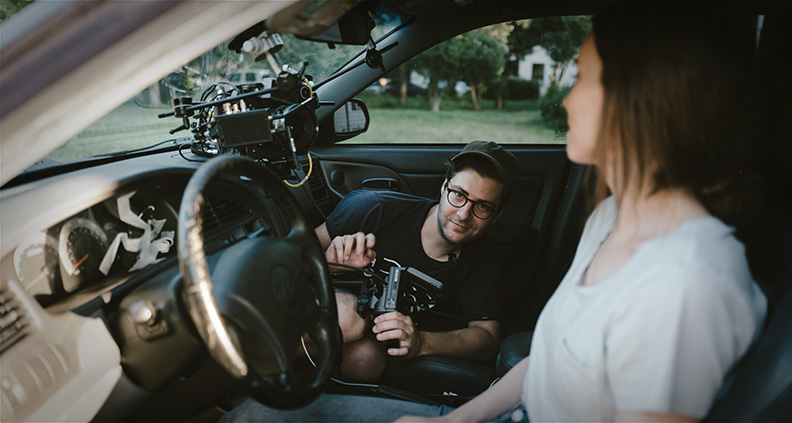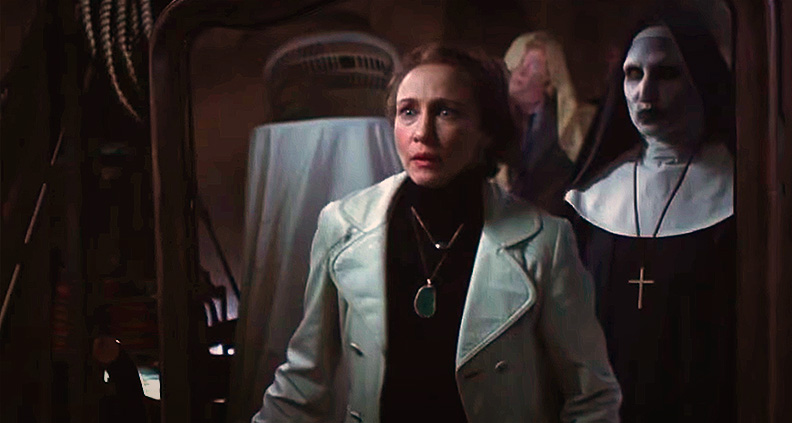Interview: ‘A Ghost Story’ Cinematographer Learns How To Haunt a New Frame
It takes a skilled team of filmmakers to turn a comically simple ghost costume—really just a hospital sheet with oval eyeholes—into one of the year’s most profound cinematic renderings of cosmic existentialism. But such is the feat of David Lowery’s meditative A Ghost Story, which observes the metaphysical journey of one recently departed soul’s (Casey Affleck) journey through time (though, crucially, not space) whilst stuck in limbo.
Contributing to film’s effect is its stark, stately cinematography, courtesy of Film Independent Fellow Andrew Droz Palermo. Somehow, Palermo—whose 2013 Documentary Lab project Rich Hill premiered at Sundance in 2014—manages to make Ghost’s square 1.33 Academy ratio frame seem both expansive and intimate, capturing moments of Keaton-esque comedy alongside genuine scares—all without puncturing Lowery’s gentle directorial touch. The result is a mesmerizing piece of filmmaking guaranteed to haunt in more ways than one.

We recently spoke to Palermo about A Ghost Story—which co-stars Rooney Mara and is currently still in theaters—about the semi-secretive process of creating the film, rethinking blocking for an unconventional frame and The Conjuring. Read:
ANDREW DROZ PALERMO
So at what point did you become involved in A Ghost Story?
Palermo: I think I became involved as [David Lowery] was finishing up Pete’s Dragon. He was still doing color and a little sound stuff. We met a few times on the Disney lot for a few hours. I brought some photo books, just as reference. We just got to know each other a little better. It’s really a good time during pre-production to get to know your director and become familiar with his or her taste. So that’s what we did at Disney here in LA. David finished the movie and the very next day was on a plane to Dallas to start A Ghost Story.
I know the film was shot sort of semi-secretly. Were there any parameters you had to adhere to in order to maintain a low profile?
Palermo: It’s funny that people were so surprised that is was hush-hush. When it was announced many people hadn’t heard of its production at all. But we weren’t particularly cautious. We were posting lots of stuff on social media. I know David was really interested in not telling anyone’s agents or Casey or Rooney’s teams, or my team or any of the producers’ teams. We wanted it to be a low-pressure, really under-the-radar shoot so that we could have the freedom to bail. And if it didn’t work out we could say, “Eh, we tried but let’s not put it out.”
How did you and David develop the look of the film—particularly the decision to use the 1.33 aspect ratio with rounded edges?
Palermo: David came to me with 1.33 in mind. It’s even mentioned in the script: “This movie will be presented in 1.33 Academy ratio.” I’d recently shot a few commercials that were also in 1.33 and he really liked those. But the development of it was happening on set. We quickly learned there were things we were uncomfortable with. We both thought in widescreen. Putting two bodies on opposite ends of the frame in a two-shot is much more comfortable in anamorphic or in 2.39, but we didn’t have that muscle for 1.33. A lot of it was just kind of an experiment, just trying as we were going.
What did you learn about framing a shot in that aspect ratio?
Palermo: It was particularly challenging for us because we knew we wanted to make a wide movie—“wide” as in lens choice. Sometimes [it was] difficult to find a frame that felt comfortable. I found that 1.33 was particularly well suited for singles. That’s best exemplified when you see Rooney listening to the music on her headphones. It suits one body perfectly from the shoulders up. Some of the wider frames were more difficult to make feel compositionally harmonious, because we knew we wanted to go wide. Proximity to the lens became a thing. If the character got too close it became oddly humorous. So I’d say imagining the two-shots is probably the most challenging thing. Like, how do you get two people in the frame perfectly, having a conversation?

I was listening to a podcast interview with David Lowery and he mentioned The Conjuring 2 as one of the film’s reference points.
Palermo: That’s really funny. We saw that movie in pre-production together. David was terrified of the film. I actually tapped him on the shoulder at one point to tell him something about the lighting or a camera move and he jumped so hard. He looked at me and his hands were covering his face and he was wrapped in a ball. There’s some stuff where we really used the genre conventions—like the scenes with the Latino family where the ghost is in the closet. That’s 100% a genre movie convention, with the door creaking and the insert of the door handle jiggling.
What’s your process as a cinematographer like when you’re going into a new film? Does it differ based on the project?
Palermo: The way I start generally is by throwing a lot of stuff at the wall and seeing what sticks. Then you zero in on the different ways everyone’s read the script, which is also fascinating. I’m sort of in that process right now with a feature I start in September. We’re sharing imagery and when a specific scene comes up, like a scene in a hospital, I might show the director a ton of stuff I imagined the scene to be lit or shot like. You get feedback and you push it from there. As far as camera stuff, I generally try to be flexible at least on my lens selection and cater it to the project. But I want to try the new Panavision DXL and the Alexa 65 and hope to bring those out to a project soon.
Any career advice for aspiring cinematographers?
Palermo: Something that’s benefitted me is to not really wait for projects to come my way—to make things that interest me and to create things even if no one is asking for them. It helps me to learn my craft, but also to have things that become calling cards in a way. Maybe that’s a short film or music video. Of course, it’s a lot harder to put together a feature. But you don’t need anyone’s permission to go out and start making things. I always say absorb as much as you can. Watch everything and try to understand how it was made. You need to remember to focus on the story and the characters and how the camera is interacting with them.
A Ghost Story is currently in theaters, distributed by A24. For more info, please visit the film’s website. To learn more about Andrew Droz Palermo, click here.
To learn more about Film Independent’s Artist Development programs—including how to apply for the upcoming AbelCine Camera grant for cinematographers, just click here.
Learn how to become a Member of Film Independent by visiting our website, and click here to subscribe to our YouTube channel.
